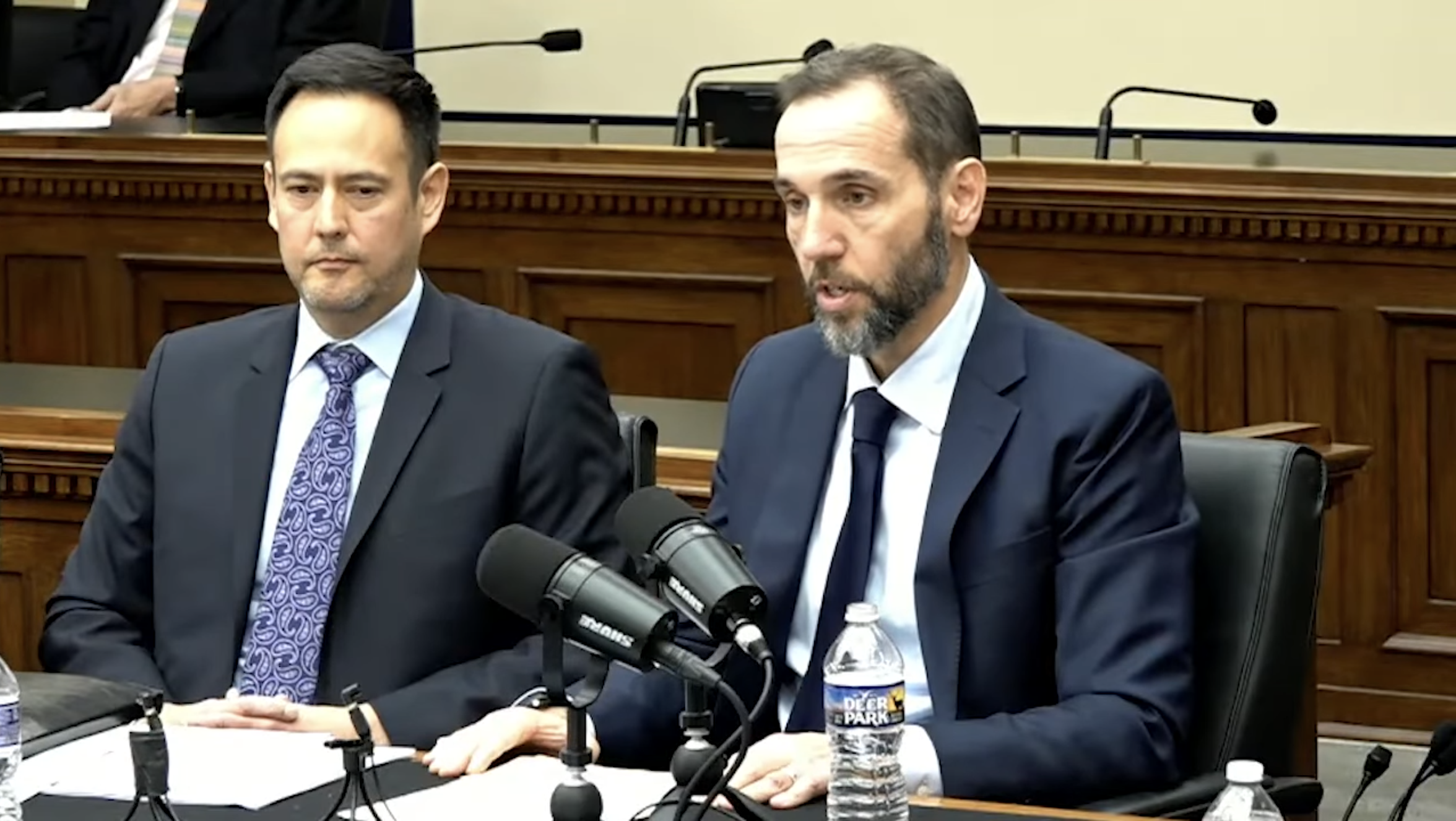What Does Starlink’s Participation in Ukrainian Defense Reveal About U.S. Space Policy?
Is America’s National Space Policy postured to control non-state actors in space?

Published by The Lawfare Institute
in Cooperation With

Recent signal jamming and cyberattacks have battered Ukrainian digital network infrastructure and caused severe outages. Reports attribute these attacks, which are consistent with prior Russia-sponsored cyber operations, to Russian actors.
In an effort to secure redundant communications capabilities, Ukrainian Minister of Digital Transformation Mykhailo Federov appealed to Elon Musk for Starlink-enabled internet. In response, Musk’s company SpaceX activated Starlink service in Ukraine and sent additional network terminals. And while USAID posits that the terminals are necessary to “safeguard” public internet access, Starlink has reportedly enabled members of the Ukrainian Aerorozvidka to carry out sophisticated intelligence collection and fire support operations against Russian positions. One Ukrainian military official even told the Times of London that he “must” use Starlink in order to acquire Russian targets with thermal imaging.
Musk corresponds with the Ukrainian government against the backdrop of a complex legal landscape. This post explores several tenets of international humanitarian law as it might govern Russian targeting of Starlink infrastructure. It then assesses how and why Musk’s actions threaten to draw the U.S. in as a party to the conflict. Finally, it proposes modifications to domestic policy that could help avoid such an outcome now and in the future.
International Humanitarian Law and Dual-Use Objects
International humanitarian law provides a framework for identifying lawful targets in war. Although states may disagree in their interpretations of specific treaty provisions, most agree on certain foundational principles.
First, combatants have a duty to distinguish between targets that constitute military objectives and those that do not. Military objectives include only those combatants or objects that, based on their nature, location, purpose, or use, make an effective contribution to military action. Civilians enjoy protection under this provision “unless and for such time” as they might substantially and effectively enhance or sustain a warmaking effort. Combatants include uniformed military personnel belonging to a party to a conflict, as well as nonuniformed personnel over which a party exercises overall control.
Second, combatants must avoid carrying out any strike that may cause suffering, injury, or destruction to noncombatants or civilians objects that would be clearly excessive in relation to the concrete and direct overall military advantage anticipated. In international humanitarian law, this is known as the principle of proportionality.
Finally, attackers must take all feasible measures to prevent collateral damage to nonmilitary objectives, including a duty to warn civilian populations that might be affected. This obligation applies only where circumstances permit such warning.
Dual-use objects, or objects that serve both a military and a civilian use, provide unique challenges to military commanders. Dual-use objects may be targets of attack only during those times when they are used for a military purpose, and when such a strike would also not be disproportionate. As system elements become more attenuated from the military actions they enable, and increasingly commingled with nonmilitary purposes, proportionality and military necessity calculus tends to disfavor attack. However, each case-by-case determination depends on the information reasonably available to military commanders and the temporality element regarding a particular object’s use.
Dual-use objects that may at times be subject to attack include several relics of traditional battlefields, such as oil refineries, bridges, tunnels, transmission facilities and factories. However, the nature of war has expanded to additional and incomparable battlefield dimensions. For example, future engagements in the cyber or space domains will likely require commanders to make real-time determinations on targets experiencing concurrent military and civilian use. Legacy rules for targeting dual-use infrastructure may not adequately address these new dimensions.
Are Starlink Satellites Now Lawful Targets?
In an age in which Command, Control, Communications, Computers, Intelligence, Surveillance and Reconnaissance (C4ISR) systems are essential to enable military operations, the satellites that perform C4ISR functions almost certainly offer a military advantage. By Musk’s own assessment, the “probability of (Starlink components) being targeted is high.” While C4ISR systems may be civilian owned and operated (such as Starlink), their integration into military networks suggests that temporal “use” analyses may be satisfied during periods of armed conflict. Although a denial of service or other adverse effect levied on a Starlink satellite would be difficult to localize and would inevitably cause harm to civilian infrastructure, the distinction prong of a targeting analysis might still be satisfied.
Achieving proportionality when attacking satellites in orbit poses unique challenges. First, at the same time that Starlink’s satellite network enables Ukrainian military officials to achieve a military advantage, it also provides service to hundreds of thousands of civilian users. Russia might possess only limited capacity to localize denials of service or tailor effects to counter only military uses. Second, unlike kinetic effects at sea level, attacks that cause fragmentation in space levy inevitable but unpredictable effects on other nonmilitary structures. Although adverse effects on the environment should weigh heavily against attack, they are not yet a per se bar to pursuing kinetic effects in outer space.
Despite unique difficulties in satisfying principles of international humanitarian law while targeting satellites in orbit, Russia would argue that degrading one of the Ukrainian military’s most viable communications systems offers exhorbitant military value. Furthermore, Russian commanders might claim that additional precautions are not feasible, that Russian President Vladimir Putin’s assessment of Ukrainian war crimes justifies escalation in a new domain, or other allegations not necessarily rooted in fact nor law.
Perhaps even more concerning, Russia has demonstrated a willingness to introduce entropy in the space domain in order to advance national interests with little regard for notions of acceptable conduct. Additional incidents of similar conduct should not come as a surprise, especially where Russia is already alleged to have launched indiscriminate and disproportionate attacks during its advance toward Kyiv. In light of these trends, the United States must be prepared to counter Russian actions against national interests, which include protecting the domestic commercial space sector and its supporting infrastructure.
Does the United States Bear the Risk of SpaceX’s Actions?
Starlink satellites are the property of SpaceX and its shareholders, but the U.S. also has a vested interest in governing their contributions to foreign military operations. National Space Policy (NSP) directs the secretary of commerce to determine whether novel commercial activities threaten international obligations. Starlink’s use likely falls in a gap between the NSP’s export policies for technology and the anticipated areas of supervision. After all, the satellite constellation itself is marketed for commercial use, and the only exports are user terminals enabling connectivity.
This distinction may abdicate responsibility under an overall control analysis, but the Outer Space Treaty of 1967 (OST) offers no such safe harbor. OST Article VI attaches state responsibility to activities in outer space, including those launched from a state’s territory, even when the activity is carried out by a nongovernmental agency. More specifically, Article VI demands that “the activities of non-governmental entities in outer space … require authorization and continuing supervision by the appropriate State Party” (emphasis added).
The USSR first proposed assignment of national responsibility for nongovernment entities’ space activities in 1962. It is quite possible the draft treaty amendment submitted on July 11, 1966, and the resulting text of the OST, can be attributed to deliberative programming aimed at addressing the ideological competition between free-market and centrally planned economic actors. Now, the ready acceptance of state attribution by the U.S. delegation may impute consequences for Musk’s contribution to the current conflict. This should cause concern for policymakers who are weighing future contributions of arms and equipment to Ukraine because no domestic legislative mechanism has been identified to authorize, or to restrain, Starlink’s current wartime contributions.
Though it may be too late to recall Musk’s Starlink terminals, the Senate Armed Services Committee is actively considering the implications of private actors in space. U.S. Space Command also acknowledges having explored the legal framework for commercial assistance in armed conflicts in coordination with the Commercial Integration Cell (CIC). According to U.S. Strategic Command, the CIC is the “first-ever collaborative government and industry effort to integrate commercial satellite owner/operators into the Combined Space Operations Center.” Depending on use cases CIC participants agree to, the commercial assets may cross the threshold of dual-use infrastructure that provide both military and civilian functionality. In these cases, it is likely increasingly difficult to determine a moment when an object loses its civilian status protection due to simultaneous use.
The CIC appears primed to address coordination of certain activities in outer space, but revisions to the NSP are necessary to address the unanticipated consequences of Article VI responsibilities. While the NSP clearly articulates the ramifications of an attack on U.S. space infrastructure, Starlink’s activities are inviting exactly such a threat. Unless the U.S. intends to take a permissive stance toward real or perceived corporate instigation in outer space, and is prepared to enter armed conflicts accordingly, industry cooperation alone is insufficient. Dual-use objects have developed into concurrent-use objects, and national policy must carefully analyze and supervise foreign provision of materiel in the space domain.
What Should the United States Do?
Russia is likely eager to remove Starlink as a confounding factor to its invasion efforts. Indeed, Russian messaging has sought to place significant blame for the invasion on Western-driven NATO expansionism. Musk’s inflammatory comments may draw the ire of Moscow, but his decision to reinforce Ukrainian C4ISR systems is all but sure to elicit a response. Whether the Russian response remains within the current conflict’s geographic boundaries remains to be seen.
The Starlink constellation may be a leading indicator for future state attribution questions under Article VI contemporaneously with armed conflict. Further exploration of the legal framework is necessary and should result in additional controls on freelancing corporations independently providing material support to belligerents. Addressing this question in the next NSP is an excellent place to start.
Dual-use space objects are increasingly transforming into concurrent-use infrastructure, obscuring defined periods of protected status, and exposing U.S. assets to a more permissive targeting calculus. Further, Department of Commerce review and supervision of novel commercial activities has proved insufficient to prevent unintended participation in foreign conflicts. The next NSP should mandate a deliberate review process for possible Article VI ramifications prior to commercial actors providing any materiel that might impute state responsibility. In the meantime, reinforcing the repercussions for targeting any U.S.-flagged space asset is likely necessary to prevent Russian targeting beyond ground-based terminals. Otherwise, Musk’s irreverent taunting may land uncomfortably close to a declaration of war.





_c.jpg?sfvrsn=9bbcc085_3)
